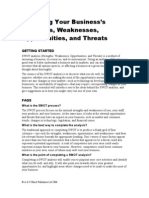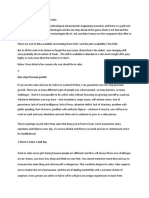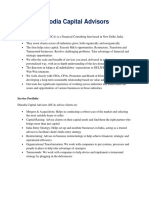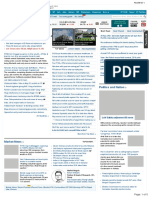Professional Documents
Culture Documents
Lesson 2
Lesson 2
Uploaded by
Sarah Jane0 ratings0% found this document useful (0 votes)
117 views40 pagesCommon stock represents ownership in a corporation with variable payments depending on company success. Derivatives derive value from other securities like stocks and bonds to transfer risk. The document then defines various types of investments including stocks, bonds, mutual funds, real estate, savings/CDs, collectibles, and their basic characteristics. It discusses risk versus return and the three main types of financial assets: fixed income, common stock, and derivatives.
Original Description:
A discussion on the securities offered to corporations
Original Title
lesson 2
Copyright
© © All Rights Reserved
Available Formats
PPTX, PDF, TXT or read online from Scribd
Share this document
Did you find this document useful?
Is this content inappropriate?
Report this DocumentCommon stock represents ownership in a corporation with variable payments depending on company success. Derivatives derive value from other securities like stocks and bonds to transfer risk. The document then defines various types of investments including stocks, bonds, mutual funds, real estate, savings/CDs, collectibles, and their basic characteristics. It discusses risk versus return and the three main types of financial assets: fixed income, common stock, and derivatives.
Copyright:
© All Rights Reserved
Available Formats
Download as PPTX, PDF, TXT or read online from Scribd
Download as pptx, pdf, or txt
0 ratings0% found this document useful (0 votes)
117 views40 pagesLesson 2
Lesson 2
Uploaded by
Sarah JaneCommon stock represents ownership in a corporation with variable payments depending on company success. Derivatives derive value from other securities like stocks and bonds to transfer risk. The document then defines various types of investments including stocks, bonds, mutual funds, real estate, savings/CDs, collectibles, and their basic characteristics. It discusses risk versus return and the three main types of financial assets: fixed income, common stock, and derivatives.
Copyright:
© All Rights Reserved
Available Formats
Download as PPTX, PDF, TXT or read online from Scribd
Download as pptx, pdf, or txt
You are on page 1of 40
Common Stock and Derivatives
• Common Stock is equity or ownership in a
corporation.
– Payments to stockholders are not fixed, but depend
on the success of the firm
• Derivatives
– Value derives from prices of other securities, such as
stocks and bonds
– Used to transfer risk
Stocks- An investment that represents
ownership in a company or corporation.
Bonds- A security representing a loan of
money from a lender to a borrower for a set
time period, which pays a fixed rate of
interest.
Mutual Fund- An investment that pools
money from several investors to buy a
particular type of investment, such as stocks.
Real Estate- An investor buys pieces of
property, such as land or a building, in hopes
of generating a profit.
Savings/Certificates of Deposits
• A deposit that earns a fixed interest rate for a
specified length of time.
– The longer the time period the greater the rate of
return.
– There is a substantial penalty for early withdrawal.
Collectibles
• Unique items that are relatively rare or highly
valued.
– Art work
– Baseball trading cards
– Coins
– Automobiles
– Antiques
Risk vs. Return
• On average, stocks have a high rate of return
– The increase or decrease in the original purchase price of
an investment
• Higher rate of return = greater risk
– Uncertainty about the outcome of an investment
• Stocks provide portfolio diversification
– Money invested in a variety of investment tools
Financial Assets
• Three types:
1. Fixed income or debt
2. Common stock or equity
3. Derivative securities
Fixed Income
• Payments fixed or determined by a formula
• Money market debt: short term, highly
marketable, usually low credit risk
• Capital market debt: long term bonds, can be
safe or risky
Principles for Successful Investing
• Watch overconfidence
– Men trade 45% more than women
• Their annualized returns were 2.7% less
– Single men trade 67% more than single women
• Their annualized returns were 1.4% less
– Most investors have significantly (> 5% a year)
underperformed the market over the last 20 years
• Watch on-line trading
– Before on-line, investors beat the market by 1.9%
• Afterwards, they underperformed by 3.6%
Carla Fried, “The Problem with your Investment Approach,” Business 2.0, November 2003,
p. 146
Principles for Successful Investing
2. Understand Risk
– Risk is inherent in all investing activities
• There are lots of different types of risk
– Inflation, business, interest rate, financial, market, political
and regulatory, exchange rate, call, and liquidity risk
– Invest at a risk level you are comfortable with
• Find that risk level
– Taking a risk tolerance test may help. Take TT16 – A Risk
Tolerance Test to get a sense on how much risk you can
tolerate
Principles for Successful Investing
3. Stay diversified
– Always invest in different asset classes and assets
• Diversification is your key defense against risk
– Make sure you understand the risks of each and every asset
class you invest in
• It’s a risky place out there. Be prepared!
– Remember that the numbers you see for specific asset class
performance are from diversified portfolios, not single assets!
– Use TT23 – Return Simulation Worksheet to see the effects of
diversification
4. Invest low cost and tax-efficiently
– Control what you can.
• You cannot control returns, but you can control your
costs, fees, and taxes
– A $1 saved is more than a $1 earned because:
» You pay taxes, charitable contributions and savings on
every new dollar earned, and a dollar saved can earn
income and income on income (compound interest)
• Realize that frequent trading incurs significant costs,
both in terms of transactions costs and taxes
5. Invest long-term
– Avoid short-term and day trading
• Its expensive and generates transactions costs and
taxes
– Invest wisely
• There are no get-rich-quick schemes that work.
– Stay at least partly in the market
• Taking money out of the market or not continuing to
save and invest stops your progress
6. If you must invest in individual assets, know
what you invest in and who you invest with
– When investing in individual assets, do your
homework
• Know what you are investing in
• Know who you are investing with
• Be aware of the environment in which the company
operates
• Be very careful and invest wisely
7. Monitor portfolio performance
– Measure performance. President Thomas S. Monson
stated:
When performance is measured, performance improves.
Where performance is measured and reported, the rate of
improvement accelerates (General Conference reports,
1970).
– How can you know how you are doing if you don’t check your
performance against some benchmark?
– Interestingly, most investors have underperformed the
market benchmarks over the last 20 years
• (DALBAR’s Annual Quantitative Analysis of Investor Behavior 2014)
8. Don’t waste too much time, money, and
energy trying to beat the market, unless you
have a lot of time, money, and energy
– It is very difficult, expensive, and time consuming
to try and beat the market
• If you want to trade, trade tax-efficiently and in tax-
deferred accounts
– If your actively managed funds under-perform, look to index
funds as inexpensive, tax efficient and very viable alternatives
to actively managed funds
9. Invest only with high quality, licensed, and
reputable people and institutions
– When help is needed, don’t be afraid to get help.
• But get good help from good people consistent with the
principles discussed
• And compare the performance of that help to your
benchmarks after taxes (and to a passive portfolio)
– Use the best resources available
• Know how those resources are compensated
• Work only with licensed and registered advisors
• Get references for any resources
10. Develop a good investment plan consistent
with your goals, budget, and these principles,
and follow it closely
– Think it through and write it wisely
• It’s your roadmap to success
– If you write it wisely and invest accordingly, it will
save you much heartache in the future
• And you will likely achieve your personal goals
• Understand key investment basics:
– What is investing?
• The giving up of something important to us now in order to
get something better in the future
– What is sacrifice?
• The giving up of something important to us now in order to
get something better in the future
– Are they similar?
• Yes
– Do we all invest?
• Definitely yes
Investment Basics (continued)
• Why do we invest?
– From our view:
• To accomplish our personal and family goals
• To have resources for retirement, education, etc.
• To grow our financial assets to serve and bless our families
and others
– From the Lord’s view:
• To bring us to Christ
• To help us achieve our divine missions
• To help us return with our families with honor
• To teach us to be “wise stewards”
• The difference between investing and gambling?
Investing: The odds are in your favor
• There is a favorable risk-return tradeoff
• It is part of a long-term plan
• You have done your homework
• It involves the creation of wealth
Gambling: The odds are in another’s favor
• There is no favorable risk-return tradeoff
• There is no long-term plan
• There is no homework, only chance
• It is a zero-sum game—no wealth is created
– Principle: Know the difference
• Are there things you should do before you
start investing?
– Is there a priority to paying bills?
– Are there certain things you should never do
without?
– Are their other bills more important than
investing?
– Is there a purpose to investing?
• Money market securities
• Stocks
– Primary and secondary stock markets
– Primary market: a market where newly issued
securities are traded
• Initial public offering (IPO): the first offering
of a firm’s stock to the public
– Secondary market: a market where existing stocks
are traded
Types of Investment
• Types of stock investors
– Institutional investors: professionals who are
responsible for investing the money
of a financial institution on behalf of their clients
– Portfolio managers: employees of financial
institutions who make investment decisions
– Individual investors: individuals who invest a
portion of their own money
• Return from investing in stock
– Returns come through dividends and price
appreciation
– Growth stocks: stocks of firms with substantial
growth opportunities
– Income stocks: stocks that provide investors with
periodic income in the form of large dividends
• Common versus preferred stock
– Common stock: a certificate issued by a firm to
raise funds that represents partial ownership in
the firm
– Preferred stock: a certificate issued by a firm to
raise funds that entitles shareholders to first
priority to receive dividends
• Less risky than common stock
• Bonds
– Return from investing in bonds is in the form of
coupon payments and price appreciation
• Mutual Funds
– Return from investing in mutual funds comes from
coupon or dividend payments generated by the
portfolio of the fund
• Publicly traded indexes: securities whose
values move in tandem with a particular stock
index representing a set of stocks
– One of the most popular is the Standard & Poor’s
Depository Receipt (S.P.D.R, also called Spider)
• Real estate
– Buying a home or purchasing rental property or
land
– Return from investing in real estate comes in the
form of rent payments and selling the property for
a higher price than paid for it
Investment Return and Risk
• Real estate
Buying a home or purchasing rental property
or land
Return from investing in real estate comes in
the form of rent payments and selling the
property for a higher price than paid for it
• Risk from investing
– Returns are uncertain
– Future values of investments are dependent on
demand by investors
– Before you select an investment, you should
assess the risk
Investment Return and Risk
– Measuring an investment’s risk
• Range of returns: returns of a specific investment over
a given period
• Standard deviation of returns: the degree of volatility in
the stock’s return over time
• A risky stock will normally have a relatively wide range
of returns and a high standard deviation of returns
• There are other subjective measures of risk
Investment Return and Risk
• Return-risk tradeoff among stocks
– Small firms tend to have more growth potential,
but higher risk
– IPOs may offer high returns, but also have high
risk, especially for individual investors
• Return-risk tradeoff among bonds
– Large, well-known firms have low return, low risk
– High risk bonds offer higher payments
• Risk-return tradeoff among mutual funds
– Mutual funds containing small stocks are more
risky than those containing large stocks
– Mutual funds containing bonds of weak
corporations are more risky than those with bonds
of creditworthy corporations
• Risk-return tradeoff among mutual funds
– Mutual funds containing small stocks are more
risky than those containing large stocks
– Mutual funds containing bonds of weak
corporations are more risky than those with bonds
of creditworthy corporations
Learning From the Investment
Mistakes of Others
• Making decisions based on unrealistic goals
• Borrowing to invest
• Taking risks to recover losses from previous
investments
• Focus on Ethics: Falling prey to online
investment fraud
– Avoid making decisions without facts
• Key decisions about investments that should
be included in your financial plan are:
– What are your investment goals?
– Given your existing budget, should you make
investments?
– Based on your risk tolerance, how should you
invest funds?
You might also like
- CS Project Report PDFDocument48 pagesCS Project Report PDFswarajya lakshmi chepuri100% (2)
- Pecking Order TheoryDocument2 pagesPecking Order TheoryMillat Afridi0% (1)
- Investor Pitch Deck TemplateDocument17 pagesInvestor Pitch Deck Templatearjun0505No ratings yet
- Investment Risk ManagementDocument20 pagesInvestment Risk Managementthink12345No ratings yet
- ACF 602/622 Coursework: Group 53Document13 pagesACF 602/622 Coursework: Group 53Shihab HasanNo ratings yet
- Ch-12 Recommending Model Portfolios and Financial PlansDocument8 pagesCh-12 Recommending Model Portfolios and Financial PlansrishabhNo ratings yet
- Investing BasicsDocument8 pagesInvesting Basicssarah123No ratings yet
- Module Business Finance Chapter 6Document4 pagesModule Business Finance Chapter 6Atria Lenn Villamiel BugalNo ratings yet
- Options CA - CS.CMA - MBA: Naveen. RohatgiDocument38 pagesOptions CA - CS.CMA - MBA: Naveen. RohatgiDivyaNo ratings yet
- Summary Slide: DR - Anup Raj Markt), PGDPM, PH.D in DerivativeDocument82 pagesSummary Slide: DR - Anup Raj Markt), PGDPM, PH.D in DerivativeNaveen KumarNo ratings yet
- Best Investing Interview Qa PDFDocument5 pagesBest Investing Interview Qa PDFGanesh Kumar RamasamyNo ratings yet
- Investment Tips For The BeginnerDocument11 pagesInvestment Tips For The Beginnerfly2vvNo ratings yet
- Phylum Cnidaria Test PDFDocument7 pagesPhylum Cnidaria Test PDFSHIKHAR SRVSTVNo ratings yet
- LN5 Writing A Business PlanDocument34 pagesLN5 Writing A Business PlansasNo ratings yet
- Fundamental of ValuationDocument39 pagesFundamental of Valuationkristeen1211No ratings yet
- Liquidity RatiosDocument7 pagesLiquidity RatiosChirrelyn Necesario SunioNo ratings yet
- Income Methods SummaryDocument2 pagesIncome Methods Summarykvel2005No ratings yet
- 2 Introduction To MarketingDocument15 pages2 Introduction To MarketingRenie Felizardo Manaois0% (1)
- Personality and Consumer BehaviorDocument5 pagesPersonality and Consumer BehaviorAbu BakarNo ratings yet
- Secondary MarketsDocument32 pagesSecondary MarketsRheneir MoraNo ratings yet
- Building Your Financial Future: A Practical Guide For Young AdultsFrom EverandBuilding Your Financial Future: A Practical Guide For Young AdultsNo ratings yet
- Financial Market Capital Market and Money Market Capital MarketDocument30 pagesFinancial Market Capital Market and Money Market Capital MarketEnayetullah RahimiNo ratings yet
- Financial AnalysisDocument23 pagesFinancial AnalysisRead BukuNo ratings yet
- Stock Market Indicies AssingmentDocument11 pagesStock Market Indicies AssingmenttullipsNo ratings yet
- Rakesh JhunjhunwalapdfDocument4 pagesRakesh JhunjhunwalapdfTowfick KamalNo ratings yet
- Pasig Catholic College: Financial Markets Chap. 2. Overview of The Financial SystemDocument51 pagesPasig Catholic College: Financial Markets Chap. 2. Overview of The Financial SystemVictorioLazaroNo ratings yet
- Put Call ParityDocument4 pagesPut Call ParityRolo TomassiNo ratings yet
- Analyzing Your Business S Strengths Weaknesses Opportunities and ThreatsDocument4 pagesAnalyzing Your Business S Strengths Weaknesses Opportunities and ThreatsJoseph NgangahNo ratings yet
- Foreign Exchange MarketDocument73 pagesForeign Exchange MarketAmit Sinha100% (1)
- Chapter - Bond and Stock ValuationDocument6 pagesChapter - Bond and Stock ValuationNahidul Islam IUNo ratings yet
- Advantages of A Sales CareerDocument3 pagesAdvantages of A Sales CareerImran KhanNo ratings yet
- Company Analysis and StockDocument8 pagesCompany Analysis and StockHaider TajNo ratings yet
- When To Sell A Stock Practical and Profitable Rules1Document4 pagesWhen To Sell A Stock Practical and Profitable Rules1satish sNo ratings yet
- Introduction To Share TradingDocument20 pagesIntroduction To Share TradingMahesh DhawadeNo ratings yet
- Investor GuideDocument7 pagesInvestor Guidefaisalshafiq1100% (1)
- Mutual Fund in Pakistan, Types and Performance EvaluationDocument7 pagesMutual Fund in Pakistan, Types and Performance Evaluationbonfument100% (2)
- Meet The Multibagger Expert Manish GoyalDocument4 pagesMeet The Multibagger Expert Manish GoyalhukaNo ratings yet
- 10 Famous Filipino Entrepreneurs (Castroverde)Document4 pages10 Famous Filipino Entrepreneurs (Castroverde)Shaina CastroverdeNo ratings yet
- Human Resource ManagementDocument30 pagesHuman Resource ManagementSalmon Roe TunaNo ratings yet
- Finance: Fig.1.1 Types of FinanceDocument8 pagesFinance: Fig.1.1 Types of FinanceKaren LacubanNo ratings yet
- StockMarketForBeginners PDFDocument15 pagesStockMarketForBeginners PDFMasthan BabuNo ratings yet
- Fundamental AnalysisDocument40 pagesFundamental AnalysisKhialani RohitNo ratings yet
- Warren BuffetDocument2 pagesWarren Buffetapi-3712836100% (1)
- 101 ETF Lessons Every Financial Advisor Should LearnDocument57 pages101 ETF Lessons Every Financial Advisor Should LearnAlejandro Peruchena100% (1)
- Entrepreneural SkillsDocument13 pagesEntrepreneural Skillssattanathan67No ratings yet
- Methodology For Calculating Sensex and Nifty 1Document3 pagesMethodology For Calculating Sensex and Nifty 1nareshNo ratings yet
- Margin Buying: ExamplesDocument13 pagesMargin Buying: ExamplesShekhar BajajNo ratings yet
- Return On EquityDocument13 pagesReturn On EquityParesh PatelNo ratings yet
- Li Lu Lecture 2010 Cbs PDF FreeDocument3 pagesLi Lu Lecture 2010 Cbs PDF FreeKostNo ratings yet
- Equity Mutual FundsDocument3 pagesEquity Mutual FundsHoney AliNo ratings yet
- Motive of Holding CashDocument8 pagesMotive of Holding CashkhandeliavivekNo ratings yet
- Adam Khoo: BY: Mita Laras WatiDocument12 pagesAdam Khoo: BY: Mita Laras WatiMitha LarasNo ratings yet
- Break Even Analysis: Presented byDocument16 pagesBreak Even Analysis: Presented byGaurav Kumar100% (1)
- Career Planning PresentationDocument22 pagesCareer Planning Presentationvnair67No ratings yet
- Magic Chess StratDocument4 pagesMagic Chess Stratbobby92No ratings yet
- How To Read Your MT4 Trading StatementDocument7 pagesHow To Read Your MT4 Trading StatementwanfaroukNo ratings yet
- Marketing 1Document55 pagesMarketing 1memerizeNo ratings yet
- The Millionaire Blueprint: Strategies for Financial Mastery and InvestingFrom EverandThe Millionaire Blueprint: Strategies for Financial Mastery and InvestingNo ratings yet
- Introduction To Finance Lecture 1Document26 pagesIntroduction To Finance Lecture 1sestiliocharlesoremNo ratings yet
- How To Change Your Life in 180 Days For Traders - by GBP TradesDocument45 pagesHow To Change Your Life in 180 Days For Traders - by GBP TradeschristopherNo ratings yet
- PWC 10 CentralDocument8 pagesPWC 10 CentralCozma BogdanNo ratings yet
- Quantum Advisors Disclosure Doc - SEBIDocument70 pagesQuantum Advisors Disclosure Doc - SEBIRajNo ratings yet
- Exercise - Vertical - Balance - SheetDocument8 pagesExercise - Vertical - Balance - SheetEjas Basheer AhamedNo ratings yet
- Ceo ProfileDocument8 pagesCeo ProfileValusha Saldanha100% (1)
- The Walt Disney Case-Pixar Case AnalysisDocument19 pagesThe Walt Disney Case-Pixar Case Analysisboldfaceaxis100% (1)
- ALMI - Annual Report - 2016 (Rugi) PDFDocument115 pagesALMI - Annual Report - 2016 (Rugi) PDFbuwat donlotNo ratings yet
- Hero Motocorp and TVSDocument4 pagesHero Motocorp and TVSPrashant AroraNo ratings yet
- Dayton, Inc. Balance Sheet As of 12/31 (Values in Millions, Except EPS and Share Price)Document4 pagesDayton, Inc. Balance Sheet As of 12/31 (Values in Millions, Except EPS and Share Price)Cattleya DianlestariNo ratings yet
- ACCT-UB 3 - Financial Statement Analysis Module 3 HomeworkDocument2 pagesACCT-UB 3 - Financial Statement Analysis Module 3 HomeworkpratheekNo ratings yet
- Ifs Cia 1.BDocument8 pagesIfs Cia 1.BAnubhav KushwahaNo ratings yet
- Dinodia Capital AdvisorsDocument2 pagesDinodia Capital AdvisorsALLtyNo ratings yet
- Ty - Bcom (Banking and Insurance)Document36 pagesTy - Bcom (Banking and Insurance)BHAVESHNo ratings yet
- 7 Ways To Shortlist The Right StocksDocument10 pages7 Ways To Shortlist The Right Stockskrana26No ratings yet
- CMS CashPooling 2010 PDFDocument44 pagesCMS CashPooling 2010 PDFtahaNo ratings yet
- M&a Course - Group2 - L&T Restructuring The Cement BusinessDocument12 pagesM&a Course - Group2 - L&T Restructuring The Cement BusinessSaswata Banerjee100% (1)
- Tax Planning For Russian Clients and Investments in RussiaDocument2 pagesTax Planning For Russian Clients and Investments in RussiaRoustam VakhitovNo ratings yet
- (Hyundai Glovis) Kis London NDRDocument23 pages(Hyundai Glovis) Kis London NDRpravanthbabuNo ratings yet
- PNB MetLife India Insurance Co LTD - DRHP PDFDocument537 pagesPNB MetLife India Insurance Co LTD - DRHP PDFSuraj100% (1)
- Securities and Exchange Commission: Sec Form 17-C, As AmendedDocument2 pagesSecurities and Exchange Commission: Sec Form 17-C, As AmendedJohn AzellebNo ratings yet
- Sukriti Project Report NevaDocument51 pagesSukriti Project Report NevaujranchamanNo ratings yet
- Satyam ScandalDocument9 pagesSatyam ScandalAmol AggarwalNo ratings yet
- Diamond Eagle Acquisition Corporation S-4Document15 pagesDiamond Eagle Acquisition Corporation S-4Carlos JesenaNo ratings yet
- Economictimes IndiatimeDocument5 pagesEconomictimes IndiatimeSrinivas BhupathiNo ratings yet
- Ch01 Governance 3edDocument18 pagesCh01 Governance 3edSarah AliNo ratings yet
- Katalyst Wealth - A Free Guide To Grow Your Wealth by 190 TimesDocument21 pagesKatalyst Wealth - A Free Guide To Grow Your Wealth by 190 TimesKatalyst WealthNo ratings yet
- VCMethod PDFDocument10 pagesVCMethod PDFMichel KropfNo ratings yet
- CLOUDDocument2 pagesCLOUDSawan AgarwalNo ratings yet
- Company Law - ProjectDocument6 pagesCompany Law - ProjectSagar KhandelwalNo ratings yet

























































































